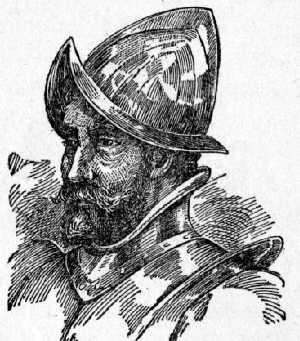 SKC Films Library SKC Films Library |
| SKC Films Library >> American History >> Discovery of America and Early Explorations |
 Pánfilo
de Narváez Pánfilo
de Narváezexplorer of Florida Pánfilo de Narváez was born into a well-to-do family in Vallenda, Spain, about 1470. Like many Spaniards of the day, Narváez had dreams of gaining wealth and glory in America, and by 1500 he was in the Caribbean. How Narváez spent his first years in the Caribbean is unknown, but in 1509 he participated in Juan de Esquivel's conquest of Jamaica. He then played a pivotal role in the Spanish conquest of Cuba under Diego Velázquez de Cuellar. After the Velázquez expedition landed on the eastern coast of Cuba late in 1511, Narváez joined him and was appointed second in command. He was promptly dispatched into the interior in charge of more than a hundred soldiers, and over the course of the next two years gained a reputation as a brutal conquistador. In 1520, Velázquez appointed Narváez leader of an expedition to Veracruz, Mexico, in order to arrest Hernán Cortés, who had defied Velázquez and personally assumed command of the expedition into central Mexico. Cortés, who was in the process of defeating the Aztec Empire at the time, left the recently subdued capital of Tenochtitlán to return to the coast to fight Narváez. On May 24, 1520, the forces of the two conquistadores clashed at Zempoala, near Veracruz, and Cortés won. Many of Narváez's soldiers deserted before and after the battle, joining Cortés, and Narváez lost an eye during the battle. Narváez was jailed in Veracruz for the next two years, while Cortés retained control of the expedition and the vast wealth that came with it. He returned to Spain upon his release, and in 1526 obtained a royal contract to establish a new settlement along the northern Gulf coast. Originally intending to settle at Río de las Palmas, just north of Cortés’ territory along the northern coast of modern Mexico, Narváez sailed from Spain with five ships and about 600 men in April 1527 and wintered along the south coast of Cuba before setting sail again in late February 1528 to resupply in Havana. A late winter storm drove the fleet much further north than planned, and by the time the expedition landed just north of present-day Tampa Bay in April about half of the men had either deserted or died. A few days after landing, Narváez began making his way north. Having brought insufficient supplies for an overland march, the expedition survived by pillaging meager native storehouses along the way, drawing violent retribution from the natives. The expedition eventually made it to an Apalachee village near present-day Tallahassee, where Narváez spent several weeks trying to find any kind of wealth. He not only failed to find wealth of any kind, he also continued to make great enemies of the natives, who in turn continued to kill expedition members whenever they could. Narváez finally decided it was time for the expedition to return to the Gulf coast, which was reached in either late July or early August. Upon reaching Apalachee Bay (south of present-day Tallahassee), Narváez found that his ships had failed to follow the coast northward as they had been ordered, so he set his remaining men to work building make-shift boats from whatever materials they could obtain. The five crude ships set sail on September 22, and pushed west along the coast for six and a half weeks, passing the mouth of the Mississippi River, before being scattered by a storm. The fate of four of the barges, including the one carrying Narváez, is unknown, but the one carrying the expedition’s treasurer Alvar Núñez Cabeza de Vaca, and fourteen other men was cast ashore on Galveston Island, off the Texas coast. Only four of those men ultimately survived, making the Narváez expedition one of the most disastrous in both American and Spanish history. |
| SKC Films Library >> American History >> Discovery of America and Early Explorations This page was last updated on 05/30/2017. |